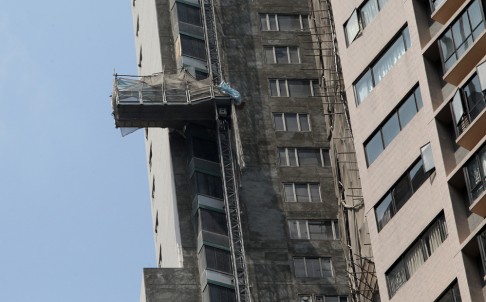Number of workers falling to death in Hong Kong hits 10-year high
Government figures show fatal falls at highest level since 2003
PUBLISHED : Sunday, 13 April, 2014, 5:08am
UPDATED : Sunday, 13 April, 2014, 8:03am
Phila Siu [email protected]

Two workers fell to their death while carrying out maintenance work from an 11-metre metal cradle at the 66-storey Tregunter Tower 3 on The Peak, when the platform snapped in two on March 25, 2014. Photo: Felix Wong
The number of people falling to their deaths at work has hit its highest level since 2003, prompting calls for tougher supervision and penalties.
The Sunday Morning Post analysed Labour Department figures on workplace deaths after the latest incident, in which two workers - a man and a woman - fell to their death from a block of flats on The Peak on March 25.
They had been carrying out maintenance work from an 11-metre metal cradle at the 66-storey Tregunter Tower 3 when the platform snapped in two. Two other workers managed to cling on as it broke apart. The two men left the scene before the emergency crew arrived and are still being sought by police.
An investigation is under way into whether illegal labour was involved, a police source said. No one has been arrested. An Electrical and Mechanical Services Department spokesman said it was assessing a report on the incident from the platform provider.
Workers' rights groups say a law under which contractors must provide safety equipment for anyone working at a height is often flouted." That's because it's expensive to provide enough safety gear but penalties imposed by the courts are always light," said Chan Kam-hong, chairman of the Association for the Rights of Industrial Accident Victims.
Labour Department figures for 2012, the most recent year for which figures are available, show that 31 people died after falling from a height in industries such as construction and transport. That is the highest death toll since 2003, the year the department began providing figures on workplace accidents on its website. Twelve workers died that year.
In 2011, 21 people fell to their deaths, up from 15 in 2010. The number was 25 in 2009. More lives were lost in the construction industry than any other: 15 in 2012; 10 in 2011; and six in 2010.
Chan said contractors were required by law to provide a work platform and safety belts for labourers working at a height of two metres or more.
The maximum penalty for breaching the law is a year in prison and a HK$500,000 fine. But most companies are fined just HK$10,000 and no one has ever gone to jail for the offence.
Chan said tougher penalties were needed to deter offenders. He added that the city could learn from Britain, where offenders could lose a proportion of their profits for flouting safety rules.
Ip Wai-ming, of the Federation of Trade Unions, said the "shockingly high" death toll was a result of inadequate inspections and a reluctance by contractors to provide enough safety gear. "Although the law states that safety belts are required, how many people are actually providing them?" said Ip, who is deputy director of the FTU's occupational health and safety committee.
There were 76,804 construction site workers across the city as of September, according to the Census and Statistics Department. It also counted 885 vacancies, but the figure may not reflect the extent of the industry's labour shortage: a survey last year by the Construction Association found a vacancy rate of 15 per cent. The shortage means more contractors are resorting to illegal labour.
The Labour Advisory Board last month approved a plan to shorten the time it takes for contractors to bring in workers via the Supplementary Labour Scheme. It will cut the process to six months, from an average of 71/2 months for 26 jobs - including bar-bending and formwork.
